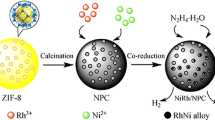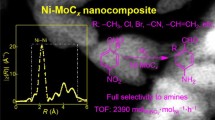Abstract
Ultra-dispersed Ni nanoparticles (7.5 nm) on nitrogen-doped carbon nanoneedles (Ni@NCNs) were prepared by simple pyrolysis of Ni-based metal—organic-framework for selective hydrogenation of halogenated nitrobenzenes to corresponding anilines. Two different crystallization methods (stirring and static) were compared and the optimal pyrolysis temperature was explored. Ni@NCNs were systematically characterized by wide analytical techniques. In the hydrogenation of p-chloronitrobenzene, Ni@NCNs-600 (pyrolyzed at 600 °C) exhibited extraordinarily high performance with 77.9 h−1 catalytic productivity and > 99% p-chloroaniline selectivity at full p-chloronitrobenzene conversion under mild conditions (90 °C, 1.5 MPa H2), showing obvious superiority compared with reported Ni-based catalysts. Notably, the reaction smoothly proceeded at room temperature with full conversion and > 99% selectivity. Moreover, Ni@NCNs-600 afforded good tolerance to various nitroarenes substituted by sensitive groups (halogen, nitrile, keto, carboxylic, etc.), and could be easily recycled by magnetic separation and reused for 5 times without deactivation. The adsorption tests showed that the preferential adsorption of −NO2 on the catalyst can restrain the dehalogenation of p-chloronitrobenzene, thus achieving high p-chloroaniline selectivity. While the high activity can be attributed to high Ni dispersion, special morphology, and rich pore structure of the catalyst.

Similar content being viewed by others
References
Formenti D, Ferretti F, Scharnagl F K, Beller M. Reduction of nitro compounds using 3d-non-noble metal catalysts. Chemical Reviews, 2019, 119(4): 2611–2680
Trandafir M M, Neatu F, Chirica I M, Neatu S, Kuncser A C, Cucolea E I, Natu V, Barsoum M W, Florea M. Highly efficient ultralow Pd loading supported on MAX phases for chemoselective hydrogenation. ACS Catalysis, 2020, 10(10): 5899–5908
Song J, Huang Z, Pan L, Li K, Zhang X, Wang L, Zou J. Review on selective hydrogenation of nitroarene by catalytic, photocatalytic and electrocatalytic reactions. Applied Catalysis B: Environmental, 2018, 227: 386–408
Wei H, Liu X, Wang A, Zhang L, Qiao B, Yang X, Huang Y, Miao S, Liu J, Zhang T. FeOx-supported platinum single-atom and pseudo-single-atom catalysts for chemoselective hydrogenation of functionalized nitroarenes. Nature Communications, 2014, 5(1): 5634
Westerhaus F A, Jagadeesh R V, Wienhofer G, Pohl M M, Radnik J, Surkus A E, Rabeah J, Junge K, Junge H, Nielsen M, Brückner A, Beller M. Heterogenized cobalt oxide catalysts for nitroarene reduction by pyrolysis of molecularly defined complexes. Nature Chemistry, 2013, 5(6): 537–543
Jagadeesh R V, Surkus A E, Junge H, Pohl M M, Radnik J, Rabeah J, Huan H, Schunemann V, Bruckner A, Beller M. Nanoscale Fe2O3-based catalysts for selective hydrogenation of nitroarenes to anilines. Science, 2013, 342(6162): 1073–1076
Sankar M, Dimitratos N, Miedziak P J, Wells P P, Kiely C J, Hutchings G J. Designing bimetallic catalysts for a green and sustainable future. Chemical Society Reviews, 2012, 41(24): 8099–8139
Gao C, Lyu F, Yin Y. Encapsulated metal nanoparticles for catalysis. Chemical Reviews, 2021, 121(2): 834–881
Munnik P, de Jongh P E, de Jong K P. Recent developments in the synthesis of supported catalysts. Chemical Reviews, 2015, 115(14): 6687–6718
Yang X, Liu W, Tan F, Zhang Z, Chen X, Liang T, Wu C. A robust strategy of homogeneously hybridizing silica and Cu3(BTC)2 to in situ synthesize highly dispersed copper catalyst for furfural hydrogenation. Applied Catalysis A: General, 2020, 596: 117518
Li J, Wang B, Qin Y, Tao Q, Chen L. MOF-derived Ni@NC catalyst: synthesis, characterization, and application in one-pot hydrogenation and reductive amination. Catalysis Science & Technology, 2019, 9(14): 3726–3734
Su D, Perathoner S, Centi G. Nanocarbons for the development of advanced catalysts. Chemical Reviews, 2013, 113(8): 5782–5816
Wang J, Kong H, Zhang J, Hao Y, Shao Z, Ciucci F. Carbon-based electrocatalysts for sustainable energy applications. Progress in Materials Science, 2021, 116: 100717
Shi Z, Yang W, Gu Y, Liao T, Sun Z. Metal-nitrogen-doped carbon materials as highly efficient catalysts: progress and rational design. Advanced Science, 2020, 7(15): 2001069
Zhang Q, Zhang D, Zhou Y, Qian J, Wen X, Jiang P, Ma L, Lu C, Feng F, Li X. Preparation of heteroatom-doped carbon materials and applications in selective hydrogenation. ChemistrySelect, 2022, 7(4): e202102581
Yang J, Li W, Wang D, Li Y. Electronic metal-support interaction of single-atom catalysts and applications in electrocatalysis. Advanced Materials, 2020, 32(49): 2003300
Shen K, Chen X, Chen J, Li Y. Development of MOF-derived carbon-based nanomaterials for efficient catalysis. ACS Catalysis, 2016, 6(9): 5887–5903
Wang Q, Astruc D. State of the art and prospects in metal-organic framework (MOF)-based and MOF-derived nanocatalysis. Chemical Reviews, 2020, 120(2): 1438–1511
Wang J, Wang Y, Hu H, Yang Q, Cai J. From metal-organic frameworks to porous carbon materials: recent progress and prospects from energy and environmental perspectives. Nanoscale, 2020, 12(7): 4238–4268
He Y, Wang Z, Wang H, Wang Z, Zeng G, Xu P, Huang D, Chen M, Song B, Qin H, Zhao Y. Metal—organic framework-derived nanomaterials in environment related fields: fundamentals, properties and applications. Coordination Chemistry Reviews, 2021, 429: 213618
Hu W, Zheng M, Xu B, Wei Y, Zhu W, Li Q, Pang H. Design of hollow carbon-based materials derived from metal—organic frameworks for electrocatalysis and electrochemical energy storage. Journal of Materials Chemistry A: Materials for Energy and Sustainability, 2021, 9(7): 3880–3917
Lakhi K S, Park D H, Al-Bahily K, Cha W, Viswanathan B, Choy J H, Vinu A. Mesoporous carbon nitrides: synthesis, functionalization, and applications. Chemical Society Reviews, 2017, 46(1): 72–101
Wang C, Kim J, Tang J, Kim M, Lim H, Malgras V, You J, Xu Q, Li J, Yamauchi Y. New strategies for novel MOF-derived carbon materials based on nanoarchitectures. Chem, 2020, 6(1): 19–40
Cheng N, Ren L, Xu X, Du Y, Dou S X. Recent development of zeolitic imidazolate frameworks (ZIFs) derived porous carbon based materials as electrocatalysts. Advanced Energy Materials, 2018, 8(25): 1801257
Song X, Jiang Y, Cheng F, Earnshaw J, Na J, Li X, Yamauchi Y. Hollow carbon-based nanoarchitectures based on ZIF: inward/outward contraction mechanism and beyond. Small, 2021, 17(2): 2004142
Han J, Meng X, Lu L, Bian J, Li Z, Sun C. Single-atom Fe—Nx—C as an efficient electrocatalyst for zinc-air batteries. Advanced Functional Materials, 2019, 29(41): 1808872
Fan Y, Zhuang C, Li S, Wang Y, Zou X, Liu X, Huang W, Zhu G. Efficient single-atom Ni for catalytic transfer hydrogenation of furfural to furfuryl alcohol. Journal of Materials Chemistry A: Materials for Energy and Sustainability, 2021, 9(2): 1110–1118
Huang L, Lv Y, Wu S, Liu P, Xiong W, Hao F, Luo H. Activated carbon supported bimetallic catalysts with combined catalytic effects for aromatic nitro compounds hydrogenation under mild conditions. Applied Catalysis A: General, 2019, 577: 76–85
Wang J, Fan G, Li F. A hybrid nanocomposite precursor route to synthesize dispersion-enhanced Ni catalysts for the selective hydrogenation of o-chloronitrobenzene. Catalysis Science & Technology, 2013, 3(4): 982–991
Zhang P, Zhao Z, Dyatkin B, Liu C, Qiu J. In situ synthesis of cotton-derived Ni/C catalysts with controllable structures and enhanced catalytic performance. Green Chemistry, 2016, 18(12): 3594–3599
Pan H, Peng Y, Lu X, He J, He L, Wang C, Yue F, Zhang H, Zhou D, Xia Q. Well-constructed Ni@CN material derived from di-ligands Ni-MOF to catalyze mild hydrogenation of nitroarenes. Molecular Catalysis, 2020, 485: 110838
Li G, Yang H, Zhang H, Qi Z, Chen M, Hu W, Tian L, Nie R, Huang W. Encapsulation of nonprecious metal into ordered mesoporous N-doped carbon for efficient quinoline transfer hydrogenation with formic acid. ACS Catalysis, 2018, 8(9): 8396–8405
Luo Z, Nie R, Nguyen V T, Biswas A, Behera R K, Wu X, Kobayashi T, Sadow A, Wang B, Huang W, Qi L. Transition metal-like carbocatalyst. Nature Communications, 2020, 11(1): 4091
Tao Y, Nie Y, Hu H, Wang K, Chen Y, Nie R, Wang J, Lu T, Zhang Y, Xu C C. Highly active Ni nanoparticles on N-doped mesoporous carbon with tunable selectivity for the one-pot transfer hydroalkylation of nitroarenes with EtOH in the absence of H2. ChemCatChem, 2021, 13(19): 4243–4250
Murugesan K, Alshammari A S, Sohail M, Beller M, Jagadeesh R V. Monodisperse nickel-nanoparticles for stereo- and chemoselective hydrogenation of alkynes to alkenes. Journal of Catalysis, 2019, 370: 372–377
Murugesan K, Beller M, Jagadeesh R V. Reusable nickel nanoparticles-catalyzed reductive amination for selective synthesis of primary amines. Angewandte Chemie International Edition, 2019, 58(15): 5064–5068
Yang F, Wang M, Liu W, Yang B, Wang Y, Luo J, Tang Y, Hou L, Li Y, Li Z, Zhang B, Yang W, Li Y. Atomically dispersed Ni as the active site towards selective hydrogenation of nitroarenes. Green Chemistry, 2019, 21(3): 704–711
Li S, Chen X, Wang J, Yao N, Wang J, Cen J, Li X. Construction the Ni@carbon nanostructure with dual-reaction surfaces for the selective hydrogenation reaction. Applied Surface Science, 2019, 489: 786–795
Li F, Ma R, Cao B, Liang J, Song H, Song H. Effect of loading method on selective hydrogenation of chloronitrobenzenes over amorphous Ni-B/CNTs catalysts. Catalysis Communications, 2016, 80: 1–4
She W, Qi T, Cui M, Yan P, Ng S W, Li W, Li G. High catalytic performance of a CeO2-supported Ni catalyst for hydrogenation of nitroarenes, fabricated via coordination-assisted strategy. ACS Applied Materials & Interfaces, 2018, 10(17): 14698–14707
Kang Y, Du H, Jiang B, Li H, Guo Y, Amin M A, Sugahara Y, Asahi T, Li H, Yamauchi Y. Microwave one-pot synthesis of CNT-supported amorphous Ni—P alloy nanoparticles with enhanced hydrogenation performance. Journal of Materials Chemistry A: Materials for Energy and Sustainability, 2022, 10(12): 6560–6568
Tang B, Song W, Yang E, Zhao X. MOF-derived Ni-based nanocomposites as robust catalysts for chemoselective hydrogenation of functionalized nitro compounds. RSC Advances, 2017, 7(3): 1531–1539
Huang L, Lv Y, Liu S, Cui H, Zhao Z, Zhao H, Liu P, Xiong W, Hao F, Luo H. Non-noble metal Ni nanoparticles supported on highly dispersed TiO2-modified activated carbon as an efficient and recyclable catalyst for the hydrogenation of halogenated aromatic nitro compounds under mild conditions. Industrial & Engineering Chemistry Research, 2020, 59(4): 1422–1435
Hahn G, Ewert J K, Denner C, Tilgner D, Kempe R. A reusable mesoporous nickel nanocomposite catalyst for the selective hydrogenation of nitroarenes in the presence of sensitive functional groups. ChemCatChem, 2016, 8(15): 2461–2465
Huang L, Tang F, Hao F, Zhao H, Liu W, Lv Y, Liu P, Xiong W, Luo H. Tuning the electron density of metal nickel via interfacial electron transfer in Ni/MCM-41 for efficient and selective catalytic hydrogenation of halogenated nitroarenes. ACS Sustainable Chemistry & Engineering, 2022, 10(9): 2947–2959
Wang H, Wang Y, Li Y, Lan X, Ali B, Wang T. Highly efficient hydrogenation of nitroarenes by N-doped carbon-supported cobalt single-atom catalyst in ethanol/water mixed solvent. ACS Applied Materials & Interfaces, 2020, 12(30): 34021–34031
Li M, Chen S, Jiang Q, Chen Q, Wang X, Yan Y, Liu J, Lv C, Ding W, Guo X. Origin of the activity of Co—N—C catalysts for chemoselective hydrogenation of nitroarenes. ACS Catalysis, 2021, 11(5): 3026–3039
Li G, Wang B, Resasco D E. Water-mediated heterogeneously catalyzed 48. reactions. ACS Catalysis, 2019, 10(2): 1294–1309
Acknowledgements
This work was supported by the National Key R&D Program of China (Grant No. 2021YFC2103704), the National Natural Science Foundation of China (Grant Nos. 21878266 and 22078288), the Science and Technology Research Project of Henan Province (Grant No. 222300420527), and Program of Processing and Efficient Utilization of Biomass Resources of Henan Center for Outstanding Overseas Scientists (Grant No. GZS2022007).
Author information
Authors and Affiliations
Corresponding authors
Electronic supplementary material
11705_2022_2220_MOESM1_ESM.pdf
Room-temperature hydrogenation of halogenated nitrobenzenes over metal—organic-framework-derived ultra-dispersed Ni stabilized by N-doped carbon nanoneedles
Rights and permissions
About this article
Cite this article
Lin, Y., Zhang, Y., Nie, R. et al. Room-temperature hydrogenation of halogenated nitrobenzenes over metal—organic-framework-derived ultra-dispersed Ni stabilized by N-doped carbon nanoneedles. Front. Chem. Sci. Eng. 16, 1782–1792 (2022). https://doi.org/10.1007/s11705-022-2220-9
Received:
Accepted:
Published:
Issue Date:
DOI: https://doi.org/10.1007/s11705-022-2220-9




